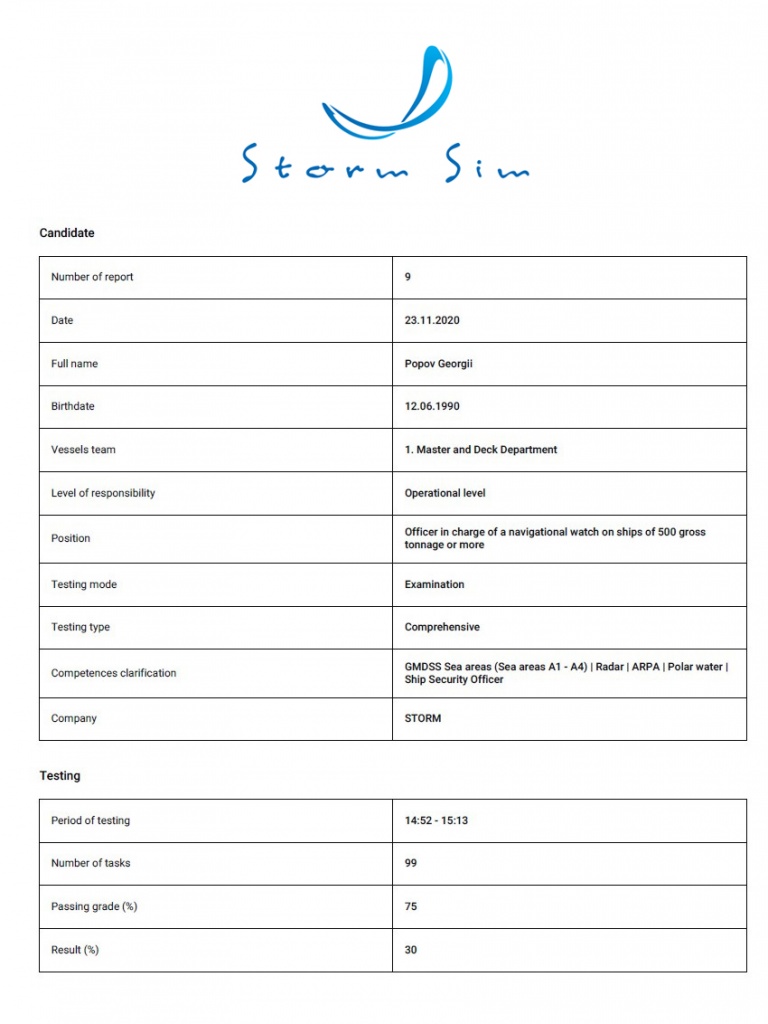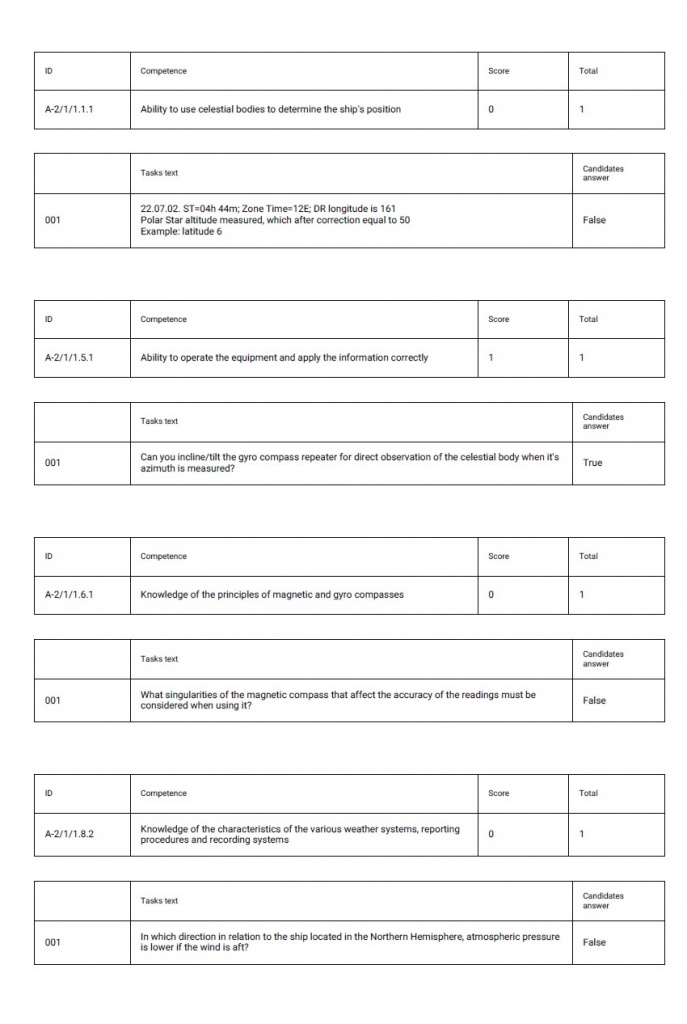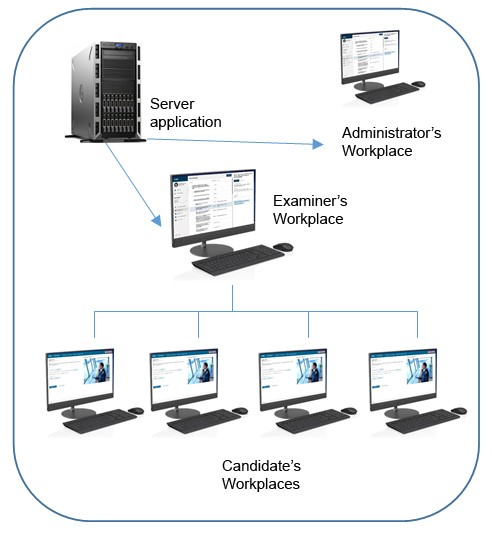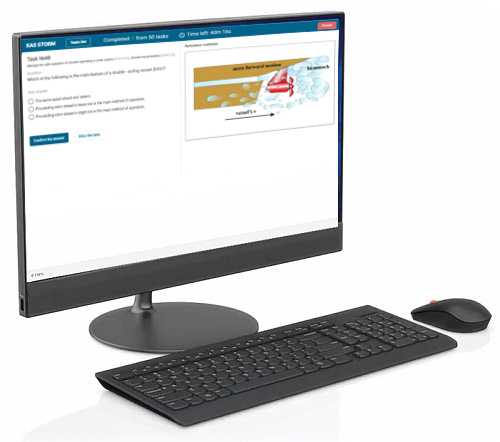KAS is designed for a comprehensive assessment of seafarers’ knowledge in accordance with the STCW Convention and other international legislation regulating maritime safety and prevention of environmental pollution.
DNV SeaSkill has verified that the software application Knowledge Assessment Software “KAS”, Version 1.1 provided by our company has been assessed in relation to Part B of the STCW Code, Chapter B-I/6, para. 11 and the competencies listed in part A of the STCW Code and confirmed that tasks and questions in KAS cover STCW Code Chapters A-II, A-IV, A-V/2, A-V/4 and A-VI.KAS can be used for face-to-face and distance testing at:
DNV Statement of Compliance officially approves that KAS can be used for comprehensive assessment of master and deck department subject to a vessel’s type (including ships operated in Polar Waters and passenger ships), installed equipment (RADAR, ARPA, ECDIS) and designated duties (security, fast rescue boats), as well as GMDSS radio operators.
|
Administration or organization that is under its authority |
Maritime educational Institution or Training Centre |
Shipping or Crewing companies |
||
|
to establish professional competence during certification, or for revalidation of certificates (Qualification Exams) according to Section A-I/11, p.1.3 of STCW Code. |
during training process, as well as for preparing cadets for Qualification Exams in the Administration according to Section A-I/6 and Section B-I/6, p.11 of STCW Code*. |
for recruitment and periodical vetting. |
Types of testing
KAS enables to provide:
|
Comprehensive testing (main purpose) |
Detailed testing |
Specific testing |
||
|
on related to candidate’s position competences listed in the tables of the STCW Code, subject to a vessel’s type, installed equipment and designated duties. |
on one or more competences relevant to a particular sphere. |
using test tasks c reated by an Examiner with help of Test Task’s Constructor. |
The contents of tests, issued within the comprehensive and detailed testing, including a set of competences and a number of tasks for each of them, are pre-determined by the manufacturer of the KAS. The contents of tests, issued within specific testing, is pre-determined by an Examiner.
It is possible to provide additional testing by competences that will be included into the test by an Examiner, based on the results of comprehensive, detailed or specific testing.
Testing modes
Testing can be provided in an examination or training modes.
The characteristics of the modes:
|
Examination |
Training |
|
|
Time is limited |
Yes | **No (by default) |
|
Comment is available*. |
No | Yes |
|
Correct answer is available. |
No | Yes |
|
Report on testing result is generated. |
Yes | Yes |
*Comment to a test task, in general, contains a link to a legislation and recommendations for choosing the correct answer.
** The time limit can be set by an Examiner.
The test in the training mode will contain all the tasks that can be issued to a candidate within a comprehensive, detailed and specific testing.
The training mode is the basic one for preparing cadets for the Qualification Exams.
Reports
After testing completion, two types of reports are created. They differ in the level of detail: standard or detailed. Reports contain some information about the testing conditions, scored points for the answers for each of the competencies, as well as the answers of candidates themselves.
Reports are saved in an archive with the ability to search for information and export to a pdf file and printouts. A header with logo and organization’s information can be added into a report.
An example of a detailed report:


Test task's database
In the database, all test tasks are systemized by competences associated with the particular position. It stores an information about content of tests, issued to a candidate.
Currently the KAS database includes about 3000 test tasks. In the nearest future, we are going to cover the competencies of the ratings and engine department.The set of seafarers’ positions available for the comprehensive testing, as well as the list of tests, that can be issued within the detail testing, are determined by license agreement with the customer.
The database can be delivered entirely or in parts, each of them includes test tasks for comprehensive testing of determined set of positions and for detailed testing by certain competencies.
Types of test tasks
KAS supports 10 types of tasks:
- choosing one correct answer from multiple
- true/false;
- choosing multiple correct answers from multiple
- type the numeric answer by keyboard
- setting the correct sequence of actions
- setting the matching by dragging and dropping phrases;
- filling up the gaps by dragging and dropping phrases;
- filling up the gaps by typing;
- choosing an area in the picture;
- setting the matching by choosing the correct answer from the combo box.
Software structure
KAS is designed in accordance with the STCW Code, Section B-I/6 “Guidance regarding training and assessment” in the part “Guidance for assessing a trainee’s progress and achievements by training by distance learning and e-learning”.
KAS consists of the Test tasks’ database, the Server application and User web-applications:- Administrator’s WorkPlace that allows registering users and initiating Test tasks’ database updates.
- Examiner’s WorkPlace that is used for issuing tests on the Candidate’s WorkPlaces, as well as for creating new tasks with help of Test Tasks Constructor.
- Candidate’s WorkPlace, where a candidate is passing a testing.

Test tasks constructor
The Constructor allows the Examiner to create test tasks of 10 types and a list of competences, and combine them into tests for specific testing.
Installation
KAS is intended to work in the local network or for distance testing via the Internet. It is required to install only the server application. All the users’ workplaces who are an Administrator, Examiners and Candidates work via browser Google Chrome 49+. The server can run under control of Microsoft Windows 7+, Microsoft Server 2012+. The server must have an external IP-address to support distance testing via the Internet.
Keeping the database up-to-date
To ensure the test tasks are kept up to date the following procedures are carried out by STORM Sim:
- A group of experts-developers of test tasks regularly monitors international legislation in the field of maritime safety, marine environment protection, maritime training and education.
- In the case of necessity, they make adjustments or add new test tasks.
- STORM Sim’s administrator, using special software, enters all the changes to the database, which is stored on the secure server on the Internet.
- The information about the readiness of the next database update is published on the STORM Sim website, as well as sent to users by email.
- A User carries out update via the Internet in accordance with the sequence specified in the User’s guide administrator’s workplace. Meanwhile all test task created by Examiner are saved without changes. When there is no an Internet connection, an update can be done using the file sent by e-mail.
Advantages
- Applying a competence approach for comprehensive and detail testing.
- Ability of knowledge assessment of seafarer subject to a vessel’s type, installed equipment and designated duties.
- Ability of providing full-being preparation for qualification exams.
- Ability of providing testing and preparation for qualification exams in distance form.
- Creating new own test tasks by an Examiner.
- An installation of Users’ WorkPlaces (Administrator, Examiner and Candidate) is not required.
General pattern of testing
After software installation, an Administrator has to register examiners and workplaces of candidates.
The examiner on his workplace chooses a type of testing (comprehensive, detailed or specific), types a candidate data and specifies the number of candidate’s workplace, where the test will be assigned.
The candidate types the number of his workplace, which the examiner told him and passes the test. After test completion, the examiner can read the report of testing result that is stored in the archive. Only user with examiner rights can access to the archive.
Additional testing can be performed for each type of testing. In this case, the examiner chooses a testing mode (training or examination) and specifies the number of issued testing tasks by each of competences.

